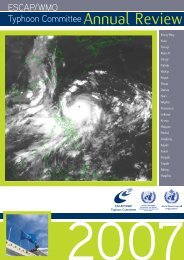TCAR - Typhoon Committee
TCAR - Typhoon Committee
TCAR - Typhoon Committee
You also want an ePaper? Increase the reach of your titles
YUMPU automatically turns print PDFs into web optimized ePapers that Google loves.
158<br />
ESCAP/WMO<br />
<strong>Typhoon</strong> <strong>Committee</strong> Annual Review 2009<br />
weakened rapidly into a tropical depression on 19 July<br />
and then dissipated over southern China later the day.<br />
GONI (0907) formed as a tropical depression over the<br />
sea east of the Philippines on 1 August, and moved<br />
generally westwards crossing the Luzon Island and<br />
entered the South China Sea the next morning, Then<br />
it turned to move northwestwards and intensified<br />
into a tropical storm on 3 August. Goni landed on<br />
the coast of Guangdong Province on 5 August and<br />
weakened into a tropical depression the next day.<br />
After crossing the Leizhou Peninsula, it gradually<br />
turned southwestwards and entered the Beibu Gulf<br />
where it intensified again into a tropical storm on 7<br />
August. While weakening into a tropical depression<br />
on 8 August, it turned southwestwards and gradually<br />
to move northeastwards. Later it dissipated over the<br />
northwestern part of the South China Sea on 10<br />
August.<br />
Morakot (0908) formed as a tropical depression<br />
over the western North Pacific on 2 August and<br />
initially moved eastwards. It soon intensified into a<br />
tropical cyclone on 3 August. It then turned to move<br />
westwards and intensified into severe tropical cyclone<br />
on 4 August and reached the typhoon intensity<br />
the next day. Morakot crossed Taiwan on 7 August<br />
and then weakened into a severe tropical storm.<br />
It gradually turned to move northwards and made<br />
landfall in Fujian Province on 9 August. It weakened<br />
further into a tropical storm and moved northwards<br />
across eastern China. Then it further weakened into<br />
a tropical depression the next day. Turning to move<br />
northeastwards, it passed over the Yellow Sea and<br />
transformed into an extra-tropical cyclone on 11<br />
August.<br />
ETAU (0909) formed as a tropical depression over the<br />
western North Pacific southwest of Iwoto Island on<br />
8 August and moved northwestwards. It intensified<br />
into a tropical storm the next day. It was gradually<br />
turning to move northeastwards on 10 August then<br />
eastwards and weakened into a tropical depression<br />
on 13 August after turning northwards. It then moved<br />
generally to the east and became an extra-tropical<br />
cyclone to the east of Japan.<br />
VAMCO (0910) formed as a tropical depression<br />
over the western North Pacific west of the Marshall<br />
Islands on 16 August and moved generally northnorthwestwards.<br />
It intensified first into a tropical<br />
storm and then a severe tropical storm on 18 August,<br />
and reached typhoon intensity the next day. It turned<br />
to move northwards on 23 August and then northnortheastwards.<br />
Vamco weakened into a severe<br />
tropical storm on 25 August and then became an<br />
extra-tropical cyclone over the western North Pacific<br />
to the east of Kamchatka Peninsula on 26 August.<br />
KROVANH (0911) formed as a tropical depression to<br />
the east of Mariana Islands on 28 August. Moving<br />
northwards, it intensified into a tropical storm that<br />
evening. Krovanh turned to move northwestwards<br />
and further intensified into a severe tropical storm on<br />
30 August. Gradually turning to move northeastwards,<br />
Krovanh traversed the eastern coast of Japan on<br />
31 August. Continuing its northeasterly trajectory,<br />
it weakened into a tropical storm and became an<br />
extra-tropical cyclone to the east of Hokkaido on 1<br />
September.<br />
DUJIAN (0912) formed as a tropical depression<br />
over the sea east of the Luzon on 2 September. At<br />
first it started to move westwards, it later turned to<br />
move eastwards and intensified into a tropical storm<br />
on 3 September. Turning to move northeastwards,<br />
it intensified further into a severe tropical storm on<br />
5 September. Dujian moved east-northeastwards<br />
across the western North Pacific to the south of<br />
Japan. It became an extra-tropical cyclone overt the<br />
western North Pacific to the east of Japan on 10 Sept.<br />
MUJIGAE (0913) formed as a tropical depression<br />
over the sea east of Luzon Island on 9 September<br />
and moved west-northwestwards. It intensified into a<br />
tropical storm over the northern part of South China<br />
Sea to the south of Hong Kong on 10 September. It<br />
turned to move westwards crossing the northern part<br />
of Hainan Island. Keeping its westerly track, Mujigae<br />
weakened into a tropical depression on 12 September<br />
after it made landfall over northern Viet Nam. It further<br />
weakened into an area of low pressure over northern<br />
Viet Nam.<br />
CHOI-WAN (0914) formed as tropical depression<br />
over the western North Pacific to the east of Guam<br />
on 12 September and moved west-northwestwards.<br />
It intensified into a tropical storm later at that day.<br />
It rapidly intensified into severe tropical storm then<br />
typhoon on 14 September after turning to move<br />
westwards. Choi-wan continued to move westnorthwestwards<br />
and gradually turning to move<br />
northeastwards. It weakened into a severe tropical<br />
storm, then rapidly transformed into an extra-tropical<br />
cyclone to the east of Japan on 20 September.<br />
KOPPU (0915) formed as a tropical depression off the<br />
northern coast of Luzon Island on 13 September and<br />
moved at first westwards. It intensified into a tropical<br />
storm as it turned to move west-northwestwards

















